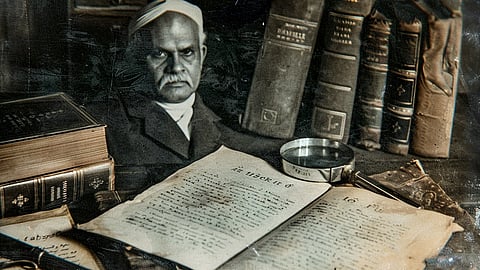- Commentary
- History Vignettes
- Notes on Culture
- Dispatches
- Podcasts
- Indian LanguagesIndian Languages
- Support

NĀRO RĀYĀJI GOḌE quickly distinguished himself as a reliable and intrepid fighter and rose up the ranks. Gangadhar Krishna Pratinidhi recognised his talent and steadily promoted him. Naro reached a high point in his career when he got permission to lead the punitive battle against Tulaji Angre. Armed with the aforementioned 5000 troops, Nāro Rāyāji Goḍe fought a ferocious battle, routed Angre’s men and wrested the Muḍāgaḍ fortress and thoroughly demolished it. To mark the victory, “a plough with an ass was dragged over the site.”
The Battle of Muḍāgaḍ was thus won by Nāro Rāyāji Goḍe on behalf of his master on 15 March 1748.
Parashuram Krishna Gode hailed from a bloodline of warriors.
Gangadhar Krishna Pratinidhi granted to Nāro Rāyāji Goḍe the Bhadkambe and Devade villages as Inam. Ever since, the two villages — located in the Sangameshwar Taluka, Ratnagiri District — remained with the Gode bloodline continuously for 180 years — i.e., till 1928. That was the year in which Sri Krishnaji Govind Gode handed over a precious family heirloom to his son, Parashuram Krishna Gode. The heirloom was in plural. They were fragments of the Gode Family Bakhar written in the Modi script. P.K. Gode narrates his tryst with this heirloom:
"Not being then interested, or trained in the investigation of family history I had put this bundle aside as it was in a fragile condition. Three years after the death of my father which took place on 3rd February 1930 I happened to search the family papers which brought to me the recollection of my father’s wish that I should study the Bakhar handed over to me. Thereupon I tried to restore successfully all the available sheets of this Bakhar and found to my great surprise that they contained a regular narrative of family history and political events, containing also accurate dates from A.D. 1726 to 1840. Presumably this Bakhar must have been written by some one after A.D. 1840 and before 1843 as it mentions the date 1840 (Saka 1762) and also refers to the regime of Amritrao Pratmidhi who ruled from 1833 to 1843." [Emphasis added]
P.K. Gode’s father happened to be the last Khot of the aforementioned villages. When P.K. Gode set out to fulfill his father’s dying wish of reconstructing his family history, he pursued the subject in his quintessential fashion: with the patience of an ant, the tenacity of a badger and the meticuolusness of a bear. The outcome included two scholarly papers on the Gode Family Bakhar labelled, “for private circulation,” published in 1936 and 1938 respectively. He continously expanded this family history as he found newer material. This is how P.K. Gode describes the fragments of the Bakhar that he received from his father:
The Gode Bakhar contains two portions which I have labelled as Part I and Part II. Part I (folios A to G) is older in appearance while Part II (folios I to VIII) is later. Each sheet measures 23 inches by five and half inches and is written on both the sides of the paper. There are about 75 lines on each sheet, so that the total extent of Parts I & II will come to about 1200 lines or 28,800 letters, as each line contains about 24 letters.
If this wasn’t enough, Gode embarked on a related scholarly voyage. He relentlessly mined the annals of history to unearth the origins and then narrated the full story of the Varna of his birth — Kārhāḍā Brāhmaṇas, who primarily hailed from Maharashtra. The result was the lasting gift of these valuable academic papers:
Raghunatha Mahadeva Ghate, a Karhada Brahmin of the 17th Century and His Works—Between A. D. 1650 and 1700, published in 1942
The Origin and Antiquity of the Caste-name of the Karahāṭaka or Kārhāḍā Brahmins, published in 1944.
Some Kārhāḍe Brahmin families at Benares (Between A.D. 1500 and 1600), published in 1944.
P.K. Gode’s deep and reverential attachment to his long and illustrious lineage (he counts 12 generations, including his own) is evident in these scholarly investigations. On a broader plane, it also reflects his commitment to a timeless Sanatana social ideal — an unshakeable belief in the sanctity of one’s Pitrs (ancestors) whose memory our society had preserved generationally. This in turn is a slice of the Sanatana value of preserving Parampara or tradition. People create and preserve Parampara. Parampara sustains the people who created it.
To be continued
The Dharma Dispatch is now available on Telegram! For original and insightful narratives on Indian Culture and History, subscribe to us on Telegram.
